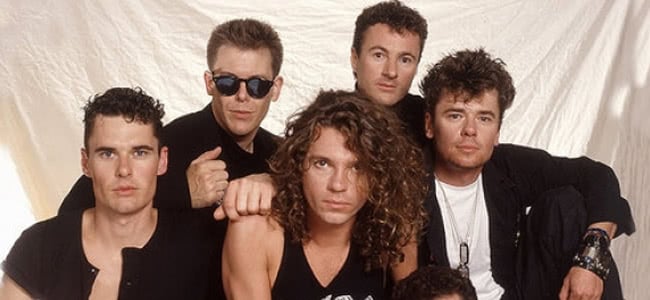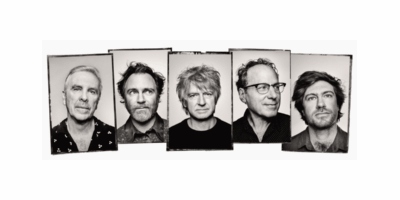INXS sold 75 million records around the world. They were not the first Australian band to rule the world and break America.
But they did it with an enviable savvy mix of anthemic songs, relentless touring, dynamic performances, uber-cool visuals, rock star lifestyle, and hardball marketing.
Mind you, the consistency of output yo-yo’d, often falling victim to road exhaustion and a series of other personal distractions.
But INXS music continues to resonate, as the release of this month’s Original Sin short movie showed.
Manager Chris Murphy was working on several INXS themed projects when he died this year – including a Broadway show, a movie based around a Michael Hutchence impersonator, and the X Building interactive museum in regional NSW.
They were all intended to keep INXS music alive and bring it to the new post-streaming generation.
12 INXS albums, ranked:
12) Switch (2005)
AC/DC’s Back In Black was a great example of a band squeezing a new singer into a dead man’s shoes and catapulting to greater heights.
Love Music?
Get your daily dose of metal, rock, indie, pop, and everything else in between.
Switch, alas, was not.
INXS’s original following probably thought it a betrayal they should go to something as uncool as reality television (Rock Star: INXS) to find a replacement for Michael Hutchence.
According to the band they chose homeless former Elvis impersonator JD Fortune because he was “on the edge” and “dangerous”.
In any case, eight years after his lonely death in Sydney’s Ritz Carlton, Hutch still cast a towering shadow over INXS, the lightweight Switch sold a miserable 390,000 copies in the US (despite the admirable track “Afterglow”), and Fortune disappeared into the mists of time.
AUS: #18, platinum
US: #17
11) INXS (1980)
The first INXS album was made at Sydney’s Trafalgar Studios on a budget of $10,000 and was a taster to their new wave-ska bent. Sessions were held after midnight, usually after a gig, and co-produced by the band with Ayers Rock’s Duncan Macguire.
“I’m not a great fan of the first album. It’s naïve and kinda cute, almost. It’s these young guys struggling for a sound,” mused frontman Michael Hutchence.
The standout ‘Just Keep Walking’, their first Top 40 hit, came from the frustration they had to get out of their situation where they were working hard but still starving.
10) Underneath The Colours (1981)
By the time of their second album, INXS were developing into a tight live act but were still awkward in the studio.
Thankfully producer Richard Clapton was encouraging them how to be more instinctive, the writing was getting less derivative, and “Stay Young”, which peaked at #21, was showing how Hutchence was incorporating his onstage swaggering persona into the music.
9) Elegantly Wasted (1997)
By the time of their 10th album, their manager Chris Murphy had got them signed with Mercury/ PolyGram in a deal rumouredly worth $40 million and the new label packed them off to Canada to work with Bruce Fairbairn to expand their resonance with the globe.
But there were dark issues at play. They were exhausted, and their stylistic mix of rock and funk sounded like they phoned in their parts.
Hutchence was bored with being a celeb rock star (he decked a photographer which cost him £20,000), was looking at cooler solo projects, and began a relationship with British TV personality Paula Yates that would destroy them both.
He would be dead seven months after the album’s release.
8) Full Moon, Dirty Hearts (1993)
The full moon ushers in all kinds of insanity. In this case, it saw Michael Hutchence get into a fight with a taxi driver — an argy-bargy that led to Hutchence crack his skull on the pavement.
Following the incident, Hutchence’s personality was never quite the same. During sessions, the late frontman through violent tantrums. This must-have affected the mood in the studio, where the band was experimenting with new directions, including an ill-advised nod to grunge.
There were good songs like ‘Time,’ ‘The Gift,’ “Days Of Rust,’ and “Please (You Got That …)” as well as duets with Ray Charles and Chrissie Hynde.
But the whole thing was a dog’s breakfast which reflected in poor sales especially in the US where it only stayed for five weeks in the charts before fleeing the scene.
7) Live Baby Live (1991)
This was recorded on July 13, 1991, on a glorious English summer day at London’s Wembley Stadium before 74,000 fans. It captured the band – and Hutchence – at their peak, delivering 16 of their gems.
But the album suffered from criticism from some quarters that a lot of the electricity was limp-noodled by tweaks in the studio –something which the band vehemently denied happened – and the accompanying video movie was regarded as a more exciting document.
6) X (1990)
In recent years, X has gone through a critical appraisal. When first released, it was overshadowed by the global blitzkrieg that was Kick, and which it followed three years later.
X sold well around the world but the general grumble, especially among earlier fans, was that while they were focussing on playing to their strengths, it was too much like Kick, still too slick and that they should have used their greater status to push the envelope more.
‘Suicide Blonde’ (driven by a Charlie Musselwhite’s harmonica sample), ‘By My Side’ and ‘Bitter Tears’ were always marvelous additions to the INXS dressing room drawer. Time has since seen cuts like ‘Disappear’ and ‘The Stairs’ grow in power, and X has been retrospectively embraced.
Also rediscovered in recent years: “Hear That Sound which Hutchence said was “about the power of people, more particularly in large crowds or in marches for the purpose of peaceful protest or celebration”.
Producer Chris Thomas would suggest in the liner notes in X’s 2002 remaster, “Everything about INXS this time around was grandiose, and this was reflected in the material.
“The album got away from the funky stuff and was moving towards the epic on tracks like ‘Lately’ and ‘The Stairs’.”
5) Shabooh Shoobah (1982)
It was on this, their third album, that INXS changed gear, and vroomed-vroomed forward to become a global band.
The mix of swagger, rock, R&B/funk, rock star aesthetics, and glossy videos with controls set to the heart of MTV finally fell in place.
These were cloaked around certified gems as ‘The One Thing’, ‘Don’t Change’, ‘To Look at You’ and ‘Black And White’.
Much of the electrifying sound was due to producer Mark Opitz. Tim Farris would explain: “Mark was the first producer that was able to capture some glimmer of what the band felt it was like live.
“Prior to us, Mark had done bands like AC/DC, Cold Chisel, The Angels. Big guitar sounds, mighty drum beats.”
In Australia, fans and media acclaimed the album’s arrival as “our boys” heading off to war, Vikings-like ready to plunder and pillage. In America, they were among the first white rock band to also draw black audiences, along with Talking Heads and Blondie. It was only years later that Red Hot Chilli Peppers made this popular in the mainstream.
4) The Swing (1984)
International touring and a 10cc boost of confidence not only muscled them up as a band but opened them up to the latest global sounds for Album Number Four.
The coolest producer at the time was Nile Rodgers of Chic, who’d made a solo album Adventures In The Land Of The Good Groove.
INXS met him backstage during a Canadian show and he agreed to produce a track for them at New York’s Power Station studios.
Hutchence and Andrew Farriss turned up with a song called ‘Brand New Day’, inspired by the singer driving past a schoolyard of kids of all colors playing together. He said the song was about “kids and conditioning. Growing up. How you grow up through other people’s ideas or your own.”
The title became the less woozy ‘Original Sin’, with the line initially “Dream on white boy, dream on white girl.”
Rodgers, whose parents were interracial, suggested the “black boy white girl” line “I come from an interracial couple. Psychologically that makes it a bigger statement.”
Telling a white boy and black girl to “play with fire” and “dream on, the name of love” was a daring step, and inevitably got it banned by some radio stations in the Deep South.
But the groove and the message stormed the dance clubs, reaching #1 on the US dance charts but stalling at #58 on pop charts.
But no doubt about it: INXS had arrived.
The rest of The Swing was made in England with British producer Nick Launay who also fashioned a tough modern dance/rock sound, with the Garry Gary Beers & Jon Farriss rhythm section coming to the fore. ‘I Send a Message,’ ‘Burn for You’ and ‘Dancing on the Jetty’ also were hit singles around the world.
3) Listen Like Thieves (1985)
INXS continued to get better and better, as more markets fell under their spell. Listen Like Thieves just missed out on becoming an American Top 10 by one spot and was also their first UK Top 50 entry.
Their wins at video awards also showed how well their visual approach was working.
At the end of their three-month sessions in Sydney for this album, producer Chris Thomas told them the record needed one more song, one which would deliver a wham-bam hit.
And, oh, they needed to come up with one in 24 hours.
Michael and Andrew hurried back to the demos they had written for the album and cast aside. They came up with three possibilities and presented them to Thomas.
The producer fell for the irresistible groove on ‘Funk Song No 13’. He’d recall, “it was great. I thought, ‘I could listen to that groove for 10 minutes!’ I said, ‘Let’s work with that groove.”
Over two days the band worked on the track, renaming it ‘What You Need’. Sultry and oozing with super-confidence, it became their first US Top 5.
The title track and rock guitar crunchola of ‘Kiss The Dirt (Falling Down The Mountain’ were worth the price of admission alone. But throughout there was a noticeable rise in song quality. Rolling Stone described the album as “going for the jugular – or is that the groin?”
2) Kick (1987)
Thirty-four years later, and Kick still creates debate – among their fans as well as within the INXS camp itself – as just where it sits in their canon artistically. For their new global audience, Kick was a masterwork with all the best ingredients of rock as the ‘90s approached. However, for their rock crowds, the record was style over substance, more MTV sheen than was acceptable.
Kick got its title after the band spotted the word pop up in various songs – a reflection of their mindset at the time. “We wanted an album where all the songs were possible singles,” said Kirk Pengilly.
Andrew Farriss ads, “Anyone can write a song that sounds contemporary. We wanted our songs to sound like the future.”
Kick was a monster, selling 6 million in America alone and an estimated 20 million across the atlas, and making them – briefly – one of the biggest bands in the world. ‘New Sensation,’ ‘Never Tear Us Apart,’ ‘Devil Inside’ and ‘Need You Tonight’ dominated radio.
‘Guns In The Sky,’ ‘Mediate,’ ‘Calling All Nations,’ and the sharp angular rendition of ‘The Loved One’ also add to the fist-pumping quota.
Its success also made Hutchence a certified superstar – something he wanted to be at the beginning of INXS’s journey, but which he would be leaning back from once he tasted it.
When INXS’s manager Chris Murphy flew to New York and played the album to Atlantic Record bosses, there was no high-fiving. Instead, they lamented they couldn’t find a track that rock radio would warm to. They offered INXS $1 million to re-record it. Murphy refused. Instead, turning to college radio for support. As a result, Kick got such momentum that Atlantic had to release it.
1) Welcome to Wherever You Are (1992)
Welcome to Wherever You Are remains INXS’s musically most accomplished recording to date — but it came out when audiences were being excited by other styles, so it failed to get the critical acknowledgment it deserved. During the sessions, band members were going through personal stuff – babies to divorces to weddings.
“The album is very much Andrew, Michael and myself. We didn’t have everyone’s minds on the job because some of them were going through significant things in their personal lives,” says producer Mark Opitz.
The record started with the spiritual Arabic motif of “Questions” which segued into the majestic power riff of “Heaven Sent”. It was a great opener that hooked anyone who wanted to listen to music, rather than plug into trendiness.
Welcome to Wherever You Are doesn’t have the highs of some earlier hits but consistently serves up sublime songs as “Baby Don’t Cry” (one of two songs featuring a 60-piece orchestra), ‘Taste It,’ ‘Baby Don’t Cry,’ ‘Not Enough Time,’ ‘Beautiful Girl,’ ‘Back On Line’ and ‘Strange Desire’.
These popped up in different charts around the world as minor hit singles but INXS’s time had seemingly gone. The band’s decision not to tour behind it, and minimal promotion from their record label in many markets especially the US, wasn’t helping.


































